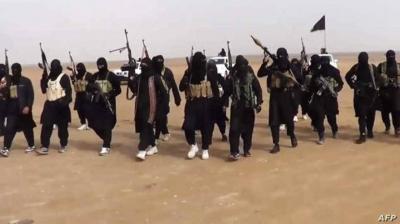Under the title "Continuous Return of ISIS Through Cross-Continental Networks Over Four Years," Sky News reported that cities in Iraq and Syria have recently witnessed movements and operations by ISIS elements. This comes amid warnings about the group regrouping in both countries, raising questions about how this "ghost" organization has returned after four years of declaring its defeat.
Experts on terrorist groups shared with "Sky News Arabia" several reasons why the return or persistence of ISIS is not surprising. Notably, ISIS has spread across various hubs in several continents, managing its wars through networks and establishing new funding and propaganda sources, while increasingly relying on "ghost warfare" or "attrition warfare."
The British newspaper "The Guardian" highlighted attempts by ISIS militants to return by attacking security checkpoints and assassinating local leaders in Iraqi cities, despite small groups of fighters remaining in the mountains and valleys. According to a tribal leader, the organization is exploiting current conditions to re-establish itself more robustly and mobilize militants and resources.
Iraqi forces in the town of Tal Afar, in western Iraq, captured a terrorist named "Asad Al-Amniya," who was responsible for transporting explosives to Mosul, and targeted ISIS hideouts in Kirkuk, northern Iraq. In Syria, military operations against the organization continued over the past two days. The Syrian army repelled an attack by ISIS on military positions in the desert area of Al-Rasafa, south-west of Raqqa, resulting in the deaths of three militants and the injury of five others.
The U.S. declared ISIS defeated in Syria in March 2019, while the Iraqi government announced the recovery of all its territories in December 2017 after battles with the group since 2014. The area liberated from ISIS in both countries was estimated at around 110,000 square kilometers, home to over 7.7 million people. ISIS was founded as a branch of Al-Qaeda in Iraq by Abu Musab al-Zarqawi in 2004, and ten years later, it split from Al-Qaeda, with Abu Bakr al-Baghdadi declaring a so-called "Caliphate" in Mosul in June 2014.
**Reasons for Return**
Political science professor Tarek Fahmy believes that ISIS "was not definitively defeated, so its return is linked to two matters: the first is the concentration of the remnants of the organization in areas in Iraq and Syria and along the Syrian-Jordanian border; the second is its lack of reliance on residing in specific countries, especially after being expelled from Syria and Iraq and failing to stabilize in alternative regions, which has prompted it to spread across multiple hubs."
Fahmy emphasized to "Sky News Arabia" that ISIS "will not return this time in its old form regarding declaring a Caliphate and establishing a stable base; rather, its elements prefer to be present in contact points and areas in southern coastal and desert regions in Africa and western Libya, to gain support from other ideologically linked terrorist groups and to control those areas, such as Boko Haram in Nigeria."
**Ghost Warfare**
A researcher in terrorist groups, Ahmed Sultan, describes ISIS's new policy, relying on "ghost warfare and guerrilla tactics" after losing geographical territory in Iraq and Syria. Sultan notes that "the geographical connectivity between the borders of the two countries facilitates the movement of elements, according to the variables of attacks launched by the organization at spaced intervals since the end of last year."
**Funding**
Sultan explains to "Sky News Arabia" that "despite the weakening of external funding sources for the organization, it possesses cash reserves estimated at around $100 million, according to estimates from the Al-Qaeda and ISIS Sanctions Committee of the Security Council," while the United Nations sanctions committee indicated that this amount represents a third of ISIS's funds.
The organization also benefits from its presence in Iraq and Syria by finding funding sources from countries in Asia and Africa, relying on timber trade, in addition to ransom money obtained from kidnapping operations.
**Attrition Warfare**
Regarding the new tools relied upon by ISIS, Fahmy indicates that "the organization has developed its media apparatus, opening new channels on Telegram and launching accounts on Twitter instead of relying on a news agency or magazine to promote its ideas." ISIS has continuously adapted its media tools, recently releasing film materials compiled from its confrontations in the battle of Mosul.
Sultan points out that ISIS’s tactics have exploited the "post-defeat" phase to operate freely after shedding the burdens of managing cities under its control. During the COVID-19 pandemic, it launched "attrition battles" by pressuring Syrian, Russian, and Kurdish forces through attacks against the desert region and Idlib in northern Syria.
He adds: “In Iraq, ISIS resorted to economic attrition by targeting electrical and oil facilities, pressuring the government, and dispersing its forces between fighting against it and seeking solutions to ongoing crises.” Sultan also mentions hints from the organization's leaders about targeting prisons, indicating plans to create significant chaos, especially with an estimated 10,000 fighters remaining in Syria and Iraq, according to UN estimates.
**Ongoing Confrontation**
To support the war against ISIS, the international coalition delivered equipment worth $2.5 million to the Iraqi Ministry of Interior, including 35 four-wheel drive vehicles and 15 loaders. A delegation from the coalition and the U.S. army visited the city of Raqqa for the first time since the withdrawal in October 2019.
Sultan believes that the international coalition, led by the U.S. and France, is engaged in aerial operations against ISIS, which have proven partially successful in eliminating the organization, but its ideas persist, facilitating its concentration in areas such as the Hamrin Hills in Diyala, the desert region, and Anbar in Iraq, as well as the desert areas between Raqqa countryside, east of Hama, and some northeastern regions of Syria.




